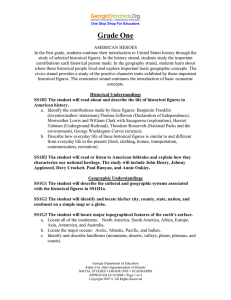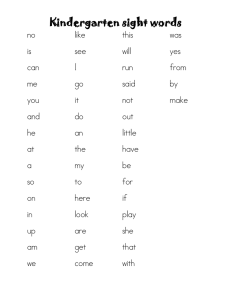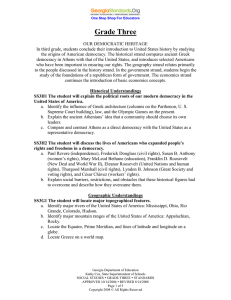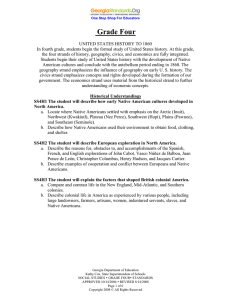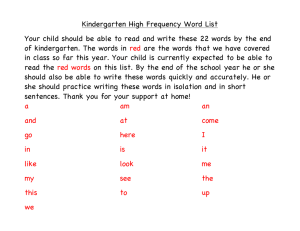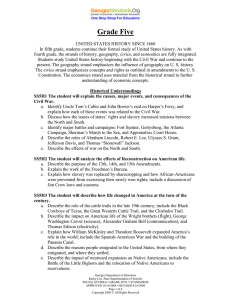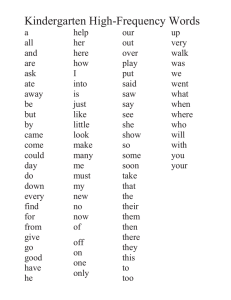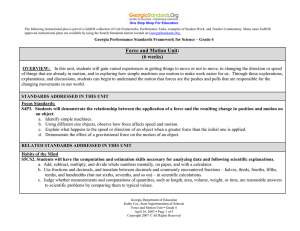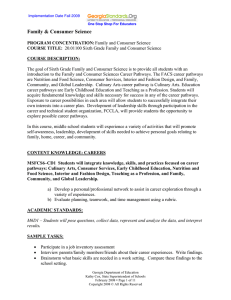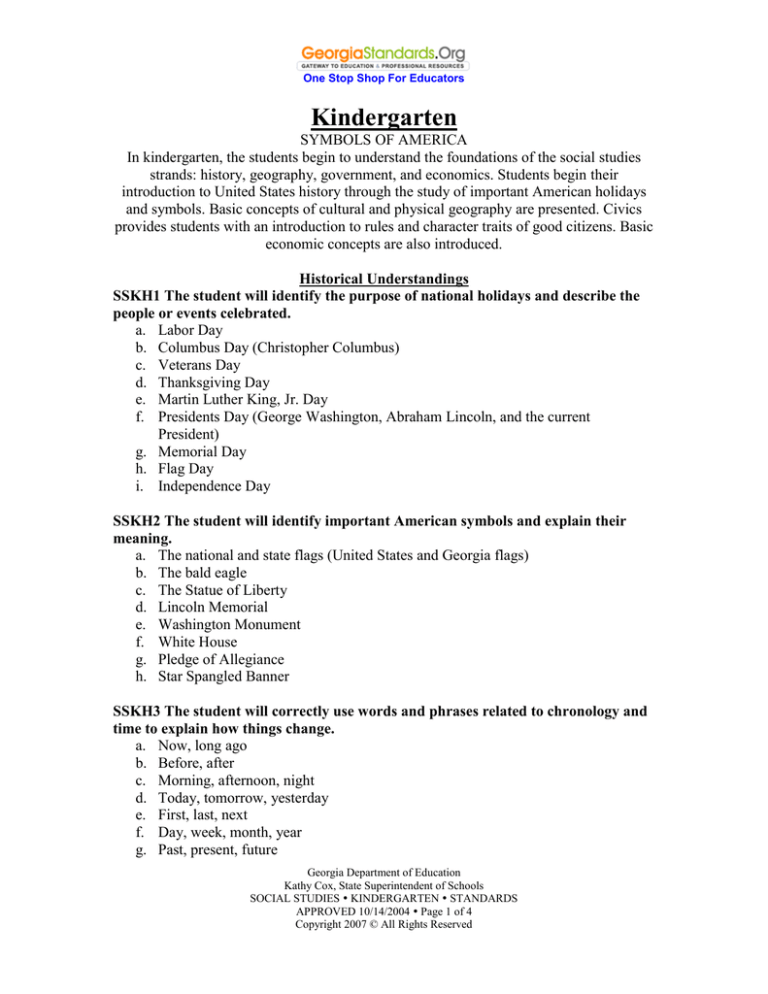
One Stop Shop For Educators
Kindergarten
SYMBOLS OF AMERICA
In kindergarten, the students begin to understand the foundations of the social studies
strands: history, geography, government, and economics. Students begin their
introduction to United States history through the study of important American holidays
and symbols. Basic concepts of cultural and physical geography are presented. Civics
provides students with an introduction to rules and character traits of good citizens. Basic
economic concepts are also introduced.
Historical Understandings
SSKH1 The student will identify the purpose of national holidays and describe the
people or events celebrated.
a. Labor Day
b. Columbus Day (Christopher Columbus)
c. Veterans Day
d. Thanksgiving Day
e. Martin Luther King, Jr. Day
f. Presidents Day (George Washington, Abraham Lincoln, and the current
President)
g. Memorial Day
h. Flag Day
i. Independence Day
SSKH2 The student will identify important American symbols and explain their
meaning.
a. The national and state flags (United States and Georgia flags)
b. The bald eagle
c. The Statue of Liberty
d. Lincoln Memorial
e. Washington Monument
f. White House
g. Pledge of Allegiance
h. Star Spangled Banner
SSKH3 The student will correctly use words and phrases related to chronology and
time to explain how things change.
a. Now, long ago
b. Before, after
c. Morning, afternoon, night
d. Today, tomorrow, yesterday
e. First, last, next
f. Day, week, month, year
g. Past, present, future
Georgia Department of Education
Kathy Cox, State Superintendent of Schools
SOCIAL STUDIES KINDERGARTEN STANDARDS
APPROVED 10/14/2004 Page 1 of 4
Copyright 2007 © All Rights Reserved
One Stop Shop For Educators
Geographic Understandings
SSKG1 The student will describe American culture by explaining diverse
community and family celebrations and customs.
SSKG2 The student will explain that a map is a drawing of a place and a globe is a
model of the Earth.
a. Differentiate land and water features on simple maps and globes.
b. Explain that maps and globes show a view from above.
c. Explain that maps and globes show features in a smaller size.
SSKG3 The student will state the street address, city, county, state, nation, and
continent in which he or she lives.
Government/Civic Understandings
SSKCG1 The student will demonstrate an understanding of good citizenship.
a. Explain how rules are made and why.
b. Explain why rules should be followed.
SSKCG2 The student will retell stories that illustrate positive character traits and
will explain how the people in the stories show the qualities of honesty, patriotism,
loyalty, courtesy, respect, truth, pride, self-control, moderation, and
accomplishment.
Economic Understandings
SSKE1 The student will describe the work that people do (police officer, fire fighter,
soldier, mail carrier, baker, farmer, doctor, and teacher).
SSKE2 The student will explain that people earn income by exchanging their
human resources (physical or mental work) for wages or salaries.
SSKE3 The student will explain how money is used to purchase goods and services.
a. Distinguish goods from services.
b. Identify various forms of U.S. money (coins, currency).
SSKE4 The student will explain that people must make choices because they cannot
have everything they want.
Georgia Department of Education
Kathy Cox, State Superintendent of Schools
SOCIAL STUDIES KINDERGARTEN STANDARDS
APPROVED 10/14/2004 Page 2 of 4
Copyright 2007 © All Rights Reserved
One Stop Shop For Educators
Social Studies Skills Matrices
MAP AND GLOBE SKILLS
GOAL: The student will use maps to retrieve social studies information.
I: indicates when a skill is introduced in the standards and elements as part of the content
D: indicates grade levels where the teacher must develop that skill using the appropriate content
M: indicates grade level by which student should achieve mastery, the ability to use the skill in all
situations
A: indicates grade levels where students will continue to apply and improve mastered skills
Map and Globe Skills
K 1
1. use cardinal directions
I
2. use intermediate directions
3. use a letter/number grid system to
determine location
4. compare and contrast the categories
of natural, cultural, and political features
found on maps
5. use inch to inch map scale to
determine distance on map
6. use map key/legend to acquire
information from, historical, physical,
political, resource, product and
economic maps
7. use a map to explain impact of
geography on historical and current
events
8. draw conclusions and make
generalizations based on information
from maps
9. use latitude and longitude to
determine location
10. use graphic scales to determine
distances on a map
11. compare maps of the same place at
different points in time and from
different perspectives to determine
changes, identify trends, and generalize
about human activities
12. compare maps with data sets (charts,
tables, graphs) and /or readings to draw
conclusions and make generalizations
3
4
5
6
M A
A
A
A
A A
A A
M A
A
A
A A
A A
I
M A
A
A A
A A
I
M A
A
A A
A A
I
M A
A
A A
A A
I
D
M A
A A
A A
I
D
M A
A A
A A
I
M A
A A
A A
I
D
D
D M A A
I
M A A
A A
I
M A A
A A
I
M A A
A A
I
Georgia Department of Education
Kathy Cox, State Superintendent of Schools
SOCIAL STUDIES KINDERGARTEN STANDARDS
APPROVED 10/14/2004 Page 3 of 4
Copyright 2007 © All Rights Reserved
7
8
912
2
One Stop Shop For Educators
INFORMATION PROCESSING SKILLS
GOAL: The student will be able to locate, analyze, and synthesize information related to
social studies topics and apply this information to solve problems/make decisions.
I: indicates when a skill is introduced in the standards and elements as part of the content
D: indicates grade levels where the teacher must develop that skill using the appropriate content
M: indicates grade level by which student should achieve mastery, the ability to use
the skill in all situations
A: indicates grade levels where students will continue to apply and improve mastered skills
Georgia Department of Education
Kathy Cox, State Superintendent of Schools
SOCIAL STUDIES KINDERGARTEN STANDARDS
APPROVED 10/14/2004 Page 4 of 4
Copyright 2007 © All Rights Reserved

